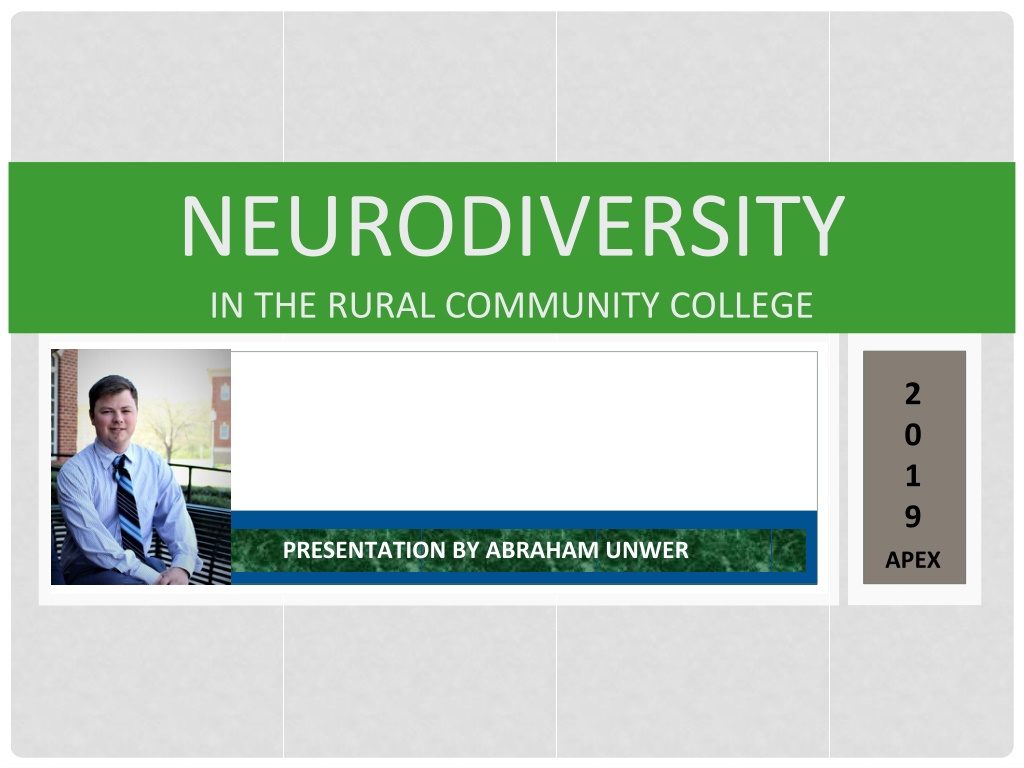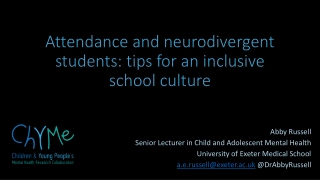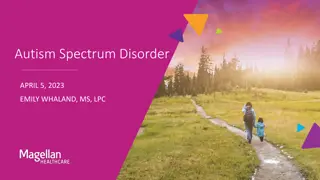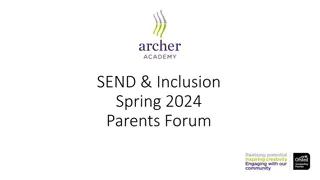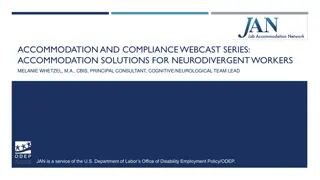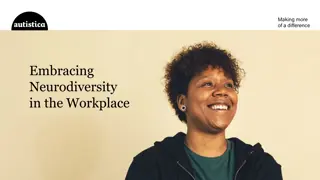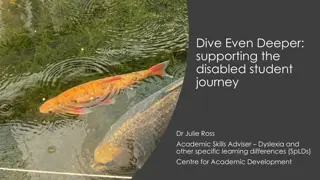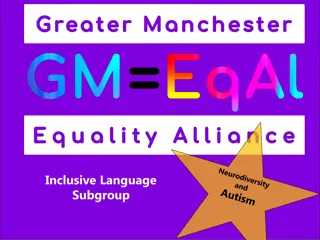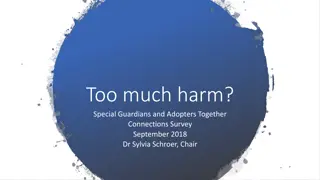NEURODIVERSITY
Neurodiversity is a vital topic that holds personal significance for the presenter due to firsthand experience with dyslexia and neurodivergent family members. The presentation aims to shed light on the challenges and strengths of the neurodiverse population and advocate for their integration into educational systems, communities, and workplaces, starting at a rural community college.
Download Presentation

Please find below an Image/Link to download the presentation.
The content on the website is provided AS IS for your information and personal use only. It may not be sold, licensed, or shared on other websites without obtaining consent from the author.If you encounter any issues during the download, it is possible that the publisher has removed the file from their server.
You are allowed to download the files provided on this website for personal or commercial use, subject to the condition that they are used lawfully. All files are the property of their respective owners.
The content on the website is provided AS IS for your information and personal use only. It may not be sold, licensed, or shared on other websites without obtaining consent from the author.
E N D
Presentation Transcript
NEURODIVERSITY IN THE RURAL COMMUNITY COLLEGE 2 0 1 9 PRESENTATION BY ABRAHAM UNWER APEX
Purpose of the Presentation To share useful, accurate information about neurodiversity To open conversations and interactions within the community
What did I study, and why is it important?
What did I study, and why is it important? The topic of neurodiversity has a special place in my heart due to my unique personal experience with dyslexia and having neurodivergent family members. Many in our community are underinformed about the challenges and strengths of the neurodiverse population. Divergent thinkers come up with new ideas that have the potential to make great advances. This has always been true. It is therefore important for us to better understand the neurodiverse population and better integrate it into the educational system, the community, and the work force. For us, this gateway begins at our rural community college.
What did I expect to find, and why?
What did I expect to find, and why? As I began this study, I expected to find standard guidelines and clear, concise information about neurodiversity and the neurodiversity movement. After all, this movement has been in process since the 1990s. I assumed the literature would affirm my comprehension of the three conditions of focus (dyslexia, ADHD, and Asperger's Syndrome), because I have personal or direct experience with these conditions. I expected to garner a brief list of useful facts and ideas that would improve the general understanding of neurodiversity. I was used to the accommodations that were available at the high school level. I anticipated that the cost of implementing services and accommodations specific to the needs of this population would be cost- preventive.
The Neurodiversity Concept "...a concept where neurological differences are to be recognized and respected as any other human variation. These differences can include those labeled with Dyspraxia, Dyslexia, Attention Deficit Hyperactivity Disorder, Dyscalculia, Autistic Spectrum, Tourette Syndrome, and others." National Symposium on Neurodiversity (2011) held at Syracuse University, New York
Neurodiversity is A collection of Naturally Occurring Neurological Conditions Marked by Difficulties in executive functioning Increased creativity
Executive Function Defined Executive functions refer to a family of top-down mental processes needed when you have to concentrate and pay attention, when going on automatic or relying on instinct or intuition would be ill-advised, insufficient, or impossible. Adele Diamond Adele Diamond is the Tier 1 Canada Research Chair Professor of Developmental Cognitive Neuroscience at the University of British Columbia, a Fellow of the Royal Society of Canada, and was recently listed as one of the 15 most influential neuroscientists.
Elements of Executive Function Organizing Planning Prioritizing Initiating Persisting
Misconceptions About Neurodiversity The public often believes it is better informed than it actually is. Conceptions of neurodiversity are over-simplified as well as amplified. The public is uncertain about how to support these students.
DYSLEXIA SLIDE TO MAKE BLANK Dyslexia
What is Dyslexia? Dyslexia is a specific learning disability that is neurobiological in origin. It is characterized by difficulties with accurate and/or fluent word recognition and by poor spelling and decoding abilities. International Dyslexia Association Albert Einstein - Theoretical physicist
Dyslexia Facts First written description, 1896 Dyslexia from Greek, difficult words or language Originally called reading blindness Not a visual impairment Lack of phonetic awareness Reading learned through a multi-sensory approach
More Dyslexia Facts Dyslexia impacts 10-20% of the population. Boys and girls are affected equally. Dyslexia is the leading cause of student dropout. Up to 90% of all learning disabilities are rooted in dyslexia. Dyslexia is not outgrown.
Signs of Dyslexia Difficulty writing and reading aloud Inconsistently misspelled words Poor reading comprehension Reading inaccuracies Trouble outlining Tom Cruise - Actor
More Signs of Dyslexia Problems with planning and time management Difficulty keeping up with objects Difficulty with deadlines Orlando Bloom - Actor
Dyslexia is often coupled with dysgraphia. This is an example from a class notebook.
Dyslexia in the Classroom Dyslexia manifests as Difficulty writing down thoughts Loss of words when speaking Above average artistic skill Poor penmanship Steven Spielberg - Film director, producer, screenwriter
Strengths of a Person with Dyslexia Right-brain dominant Strong intuition, art, and emotion Synthesizing ideas, creativity Thinking outside the box Seeing the "big picture" Spatially talented - 3D Pattern recognition Steve Jobs - Co-founder, Chairman, and CEO of Apple Inc. Primary investor and Chairman of Pixar
Common Career Interests Engineer Architect Designer Artist Mathematician Physicist Surgeon Dentist
Support for Students with Dyslexia Outlines, notes, and study guides in advance Assignments broken into smaller tasks Audio books and text-to-speech Quiet place to work Extra time
More Support Deal with content and spelling issues separately. Use alternative ways to assess knowledge. Reinforce individual coping techniques Do not ask them to read aloud in class.
What is ADHD? Attention-deficit/hyperactivity disorder (ADHD) is a brain disorder marked by an ongoing pattern of inattention and/or hyperactivity-impulsivity that interferes with functioning or development. National Institute of Mental Health
Facts about ADHD The first descriptions of ADHD symptoms were made around 1902 by Sir George Frederick Still. These children were believed to have a 'defect of moral control. The National Institute of Health (NIH) reports 6.7% of the population has ADHD. 40% may outgrow ADHD at puberty. Medication can often help control symptoms.
More Facts about ADHD There are three presentations of ADHD. Hyperactive - Impulsive Inattentive Combined ADHD is more prevalent in males than females. Males dominate hyperactive and impulsive presentations. Females dominate inattentive presentation.
Signs of Hyperactivity and Impulsivity Interrupts, may blurt out answers prematurely Fidgeting, tapping, squirming in seat Eager to be on the go Appears to not listen Difficulty being quiet May talk excessively Impatient Michael Jordan - Pro basketball player
Signs of Inattentiveness Inattentive types Absorbed in thoughts Forgetful Poor attention to details Easily distracted Careless mistakes Difficulty organizing tasks Poor follow-through Vincent van Gogh - Artist
ADHD in the Classroom Trouble keeping up with materials Poor time management, missed deadlines Frequent interruptions May talk excessively Difficulty sitting still Careless mistakes Inattentiveness Impatience Robin Williams Actor and comedian
Strengths of a Person with ADHD Creative strengths Divergent thinking Strong imagination Conducive to FLOW state (optimal brain performance) Benjamin Franklin - One of the Founding Fathers of the United States, leading author, printer, political theorist, politician, postmaster, scientist, inventor, humorist, civic activist, statesman, and diplomat
Support for Students with ADHD Quiet work area away from distractions Opportunities for movement and tactile input Clear and specific instructions Breaking tasks into smaller parts Sharing notes Extended deadlines
Aspergers Syndrome DYSLEXIA SLIDE TO MAKE BLANK A subset of Autism Spectrum Disorder (ASD)
What is Aspergers? Asperger syndrome (AS) is a neurological, developmental disorder characterized by significant difficulties in social interaction and nonverbal communication, along with restricted and repetitive patterns of behavior and interests, issues of sensory overload, and is often combined with ADHD. It seems that for success in science or art, a dash of autism is essential. Dr. Hans Asperger (1906-1980)
Facts About Aspergers First described in the 1940s by Viennese pediatrician Hans Asperger Asperger s has been referred to as the genius gene . Approximately 1% of the population of the United States have Asperger s syndrome. Many go undiagnosed. Twice as many males as females have Asperger s. Asperger s is a life-long condition.
More Facts About Aspergers 35% attend college. 75-85% unemployment (poor interview and social skills) Most experience strong empathy but have difficulty defining and expressing emotions. More likely to be taken advantage of, bullied, and become victims of violent crimes Also referred to as high-functioning autism Dogs help improve independence, quality of life, and safety.
Signs of Aspergers Less severe symptoms than other forms of autism Exceptional cognitive and language abilities at an early age Obsession with topics of interest Few facial expressions Repetitive mannerisms Avoidance of eye contact during conversation
More Signs of Aspergers Difficulty comprehending nonliteral words or phrases Hyper-awareness of all senses (sound, light, clothing textures) Sensory overload can trigger detachment Struggles with anxiety May misread social cues or facial expressions Trouble understanding verbal and non-verbal language in social contexts
Challenges of Aspergers Not understanding what others are thinking and feeling Difficulty with changes and transitions Trouble asking for help May be seizure prone Time perception Social anxiety Dawn Prince-Hughes - Anthropologist
Aspergers in the Classroom Social anxiety, unexpected emotion when stressed Difficulty talking to strangers or in group work Sensory overload in large classes May show repetitive behaviors Intense focus on interests Issues with organization May appear inattentive Daryl Hannah Actress, environmental activist
Strengths of a Person with Aspergers Ability to maintain prolonged focus on topics of interest Excellent long-term and rote memory Strong sense of fairness and justice Out of the box thinking High intelligence Strong attention to detail Noted for honesty Thomas Jefferson - Statesman, diplomat, lawyer, architect, Founding Father, 2ndU.S. vice president, 3rdU.S. president, principal author of the Declaration of Independence
More Strengths Reliable (once expectations are understood) Build friendships through shared interests Unique sense of humor Specialized interests Feel things deeply Detail oriented Temple Grandin - Professor of animal science at Colorado State University, autism spokesperson
Support for Students with Aspergers Additional ways to participate (discussion board, office visits) Step-by-step assignments to strengthen executive functioning Quiet testing environment, headphones, lighting Predictable class routine
More Support Provide explicit instructions and printed notes. Do not force eye contact, as many experience it as painful. Allow use of laptop in classroom. Allow student to leave class when overwhelmed. Advisors: Start with fewer classes, smaller classes.
What did I discover, and why is it meaningful?
What did I discover, and why is it meaningful? The findings confirmed and expanded my understandings of these topics, including the fact that each person will experience their condition in a unique and subjective way. This is important because it speaks to the complexity of such conditions. The ongoing increase of prevalence for all neurodiverse conditions is surprising information, and it reiterates the importance of taking action now.
Discovery, Cont. As I moved from comparison of rural community colleges to 4-year universities (United States, United Kingdom, Australia), I found that many best practices used to serve the neurodiverse population could be adjusted and implemented within rural community college settings at little to no financial expense.
Discovery, Cont. In order to achieve this, a significant community investment of time and support is required. The rural community college is the home-base for our friends and families, neighbors and fellow learners. We are all stakeholders in the success of one another. The first steps, then, are to present information, start conversations, and brainstorm possible solutions to some of our service needs.
What Next? How do we provide the best learning experiences for neurodiverse students without special funding?
